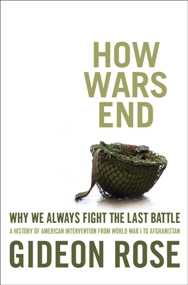
Only 12 years passed between the U.S.’s first war with Iraq and its second, but both were plagued by the same problem: postwar turmoil. As Gideon Rose explores in How Wars End: Why We Always Fight the Last Battle, understanding the relationship between the war and the aftermath has been a challenge for American policymakers as far back as World War I. Below, Rose explains just how badly we handled planning for peace in Iraq – particularly since military strategists knew the challenges that would arise – and how we need to change our conception of war, diplomacy, politics and where they meet.
 In late March 2003, the United States and a few allies invaded Iraq. Some of the war’s architects thought things would go relatively smoothly once the enemy was beaten. As National Security Adviser Condoleezza Rice put it in early April, “We fundamentally believe that when the grip of terror that Saddam Hussein’s regime has wreaked on its own people is finally broken and Iraqis have an opportunity to build a better future, that you are going to see people who want to build a better future – not blow it up.”
In late March 2003, the United States and a few allies invaded Iraq. Some of the war’s architects thought things would go relatively smoothly once the enemy was beaten. As National Security Adviser Condoleezza Rice put it in early April, “We fundamentally believe that when the grip of terror that Saddam Hussein’s regime has wreaked on its own people is finally broken and Iraqis have an opportunity to build a better future, that you are going to see people who want to build a better future – not blow it up.”
Others involved in the operation were more apprehensive. Lieutenant Colonel Steven Peterson was on the military staff that planned the ground campaign. He noted afterward:
“Over a month before the war began, the Phase IV planning group concluded that the campaign would produce conditions at odds with meeting strategic objectives. They realized that the joint campaign was specifically designed to break all control mechanisms of the [Iraqi] regime and that there would be a period following regime collapse in which we would face the greatest danger to our strategic objectives. This assessment described the risk of an influx of terrorists to Iraq, the rise of criminal activity, the probable actions of former regime members, and the loss of control of WMD that was believed to exist. It … identify[ied] a need to take some specific actions including: planning to control the borders, analyzing what key areas and infrastructure should be immediately protected, and allocating adequate resources to quickly re-establish post-war control throughout Iraq.”
These concerns and recommendations were brought to the attention of senior military leaders, “but the planners failed to persuade the Commanding General and dropped these issues with little resistance.”
In retrospect, this episode seems mystifying. It is bad enough not to see trouble coming. But to see it coming and then not do anything about it might be even less forgivable. How could such crucial, and ultimately prescient, concerns have been dismissed and abandoned so cavalierly? “Because,” Peterson continued,
“both the planners and the commander had been schooled to see fighting as the realm of war and thus attached lesser importance to post-war issues. No officer in the headquarters was prepared to argue for actions that would siphon resources from the war fighting effort, when the fighting had not yet begun…. Who could blame them? The business of the military is war and war is fighting. The war was not yet started, let alone finished, when these issues were being raised. Only a fool would propose hurting the war fighting effort to address post-war conditions that might or might not occur.”
Lieutenant General James Conway, the commander of the 1st Marine Expeditionary Force, which helped capture Baghdad, was even more succinct. Asked whether postwar planning inevitably gets short shrift compared to planning for combat, he replied, “You know, you shoot the wolf closer to the sled.”
The Iraq War will long be remembered as a striking example of such attitudes and their unfortunate consequences, but it is hardly the only one. In fact, the notion of war-as-combat is deeply ingrained in the thinking of both the American military and the country at large. Wars, we believe, are like street fights on a grand scale, with the central strategic challenge being how to beat up the bad guys. This view captures some basic truths: America’s enemies over the years have been very bad indeed, and winning wars has required beating them up. But such a perspective is misleading because it tells only half the story.
Wars actually have two equally important aspects. One is negative, or coercive; this is the part about fighting, about beating up the bad guys. The other is positive, or constructive, and is all about politics. And this is the part that, as in Iraq, is usually overlooked or misunderstood.
The coercive aspect of war involves fending off the enemy’s blows while delivering your own, eventually convincing your opponent to give up and just do what you want. This is why Carl von Clausewitz, the great Prussian military theorist, defined war as “an act of force to compel our enemy to do our will.” The constructive aspect involves figuring out what it is that you actually want and how to get it. This is why Clausewitz also defined war as “an act of policy … simply a continuation of political intercourse, with the addition of other means.”
Keeping this dual nature of war fully in mind at all times is difficult. It means recognizing that every act in war has to be judged by two distinct sets of criteria – political and military – and perhaps even by two distinct institutional sources of authority. This is messy, and nobody likes a mess. So there is a great temptation for governments to clean up matters by creating a clear division of responsibility. Civilians should deal with political matters, in this view, and military leaders should deal with military matters, and control should be handed off from the politicians and diplomats to the generals at the start of a conflict and then back to the politicians and diplomats at the end. As U.S. Central Command (Centcom) commander Tommy Franks put it to the deputy secretary of defense on the eve of the Iraq War, “You pay attention to the day after, I’ll pay attention to the day of.”
 Unfortunately, the clear-division-of-labor approach is inherently flawed, because political issues can permeate every aspect of war. The flaws can sometimes be obscured during the early and middle stages of a conflict, as each side tries to defeat the other on the battlefield. But at some point, every war enters what might be called its endgame, and then any political questions that may have been ignored come rushing back with a vengeance. “The main lines along which military events progress,” Clausewitz observed, “are political lines that continue throughout the war into the subsequent peace…. To bring a war, or one of its campaigns, to a successful close requires a thorough grasp of national policy. On that level strategy and policy coalesce: the commander-in-chief is simultaneously a statesman.”
Unfortunately, the clear-division-of-labor approach is inherently flawed, because political issues can permeate every aspect of war. The flaws can sometimes be obscured during the early and middle stages of a conflict, as each side tries to defeat the other on the battlefield. But at some point, every war enters what might be called its endgame, and then any political questions that may have been ignored come rushing back with a vengeance. “The main lines along which military events progress,” Clausewitz observed, “are political lines that continue throughout the war into the subsequent peace…. To bring a war, or one of its campaigns, to a successful close requires a thorough grasp of national policy. On that level strategy and policy coalesce: the commander-in-chief is simultaneously a statesman.”
With the war’s general outcome starting to become clear, the endgame is best thought of as a discussion over what the details of the final settlement will be and what will happen after the shooting stops. The problem is that this discussion, whether implicit or explicit, takes place under extremely trying circumstances. At least some officials on both sides may now be considering sheathing their swords, but they are doing so against the backdrop of the fighting itself: the triumphs and disasters experienced, the blood and treasure spent, the hopes and passions raised. By this point, moreover, leaders and publics have usually gotten so caught up in beating the enemy that they find it hard to switch gears and think clearly about constructing a stable and desirable political settlement. So they rarely handle endgame challenges well and usually find themselves at the mercy of events rather than in control of them.
Americans have fared on average no better than others in these situations, and sometimes worse. The country’s leaders have rarely if ever closed out military conflicts smoothly and effectively. Trapped in the fog of war, they have repeatedly stumbled across the finish line without a clear sense of what would come next or how to advance American interests amid all the chaos. They have always been surprised by what is happening and have had to improvise furiously as they pick their way through an unfamiliar and unfriendly landscape.
From How Wars End by Gideon Rose. Copyright © 2010. Reprinted by permission of Simon & Schuster, Inc, NY
*Photo of Gideon Rose by Wendi Rose. Photo of a Berlin mural bearing Clausewitz’s famous dictum that war is a continuation of policy by other means courtesy zug55.




Send A Letter To the Editors